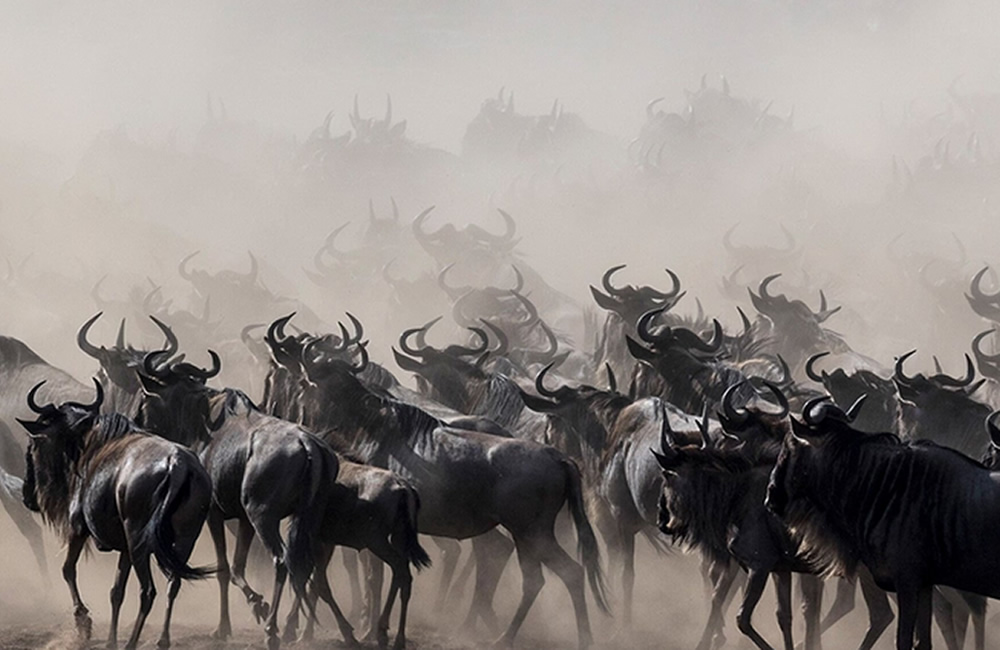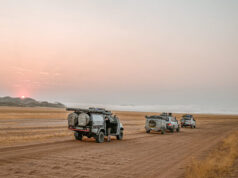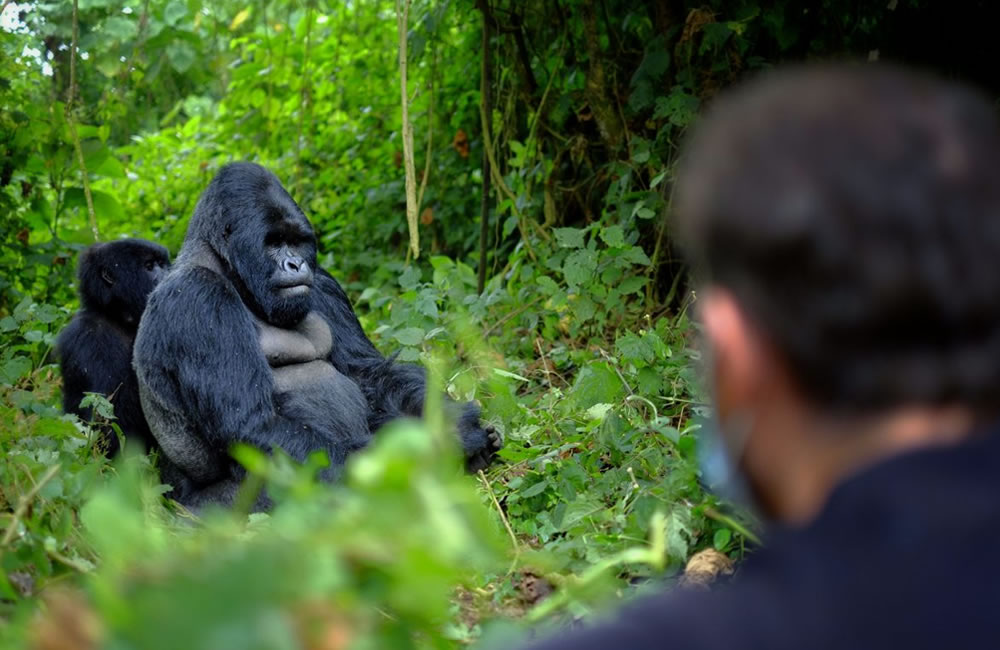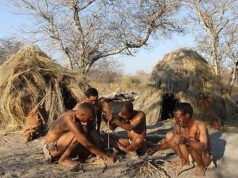Every year, millions of hooves drum against Africa’s plains, raising dust and devouring kilometres as wildebeest, zebra and gazelle trek across the Serengeti and the Masai Mara. Their odyssey, known as the Great Migration, will lead them to water and good grazing, though the way will be fraught with danger.
Needless to say, witnessing this dramatic journey is an unforgettable experience. Booking a safari during migration season will allow you to see the Great Migration Africa in action, creating unique memories that will last a lifetime.
What causes the frequent migration of animals in Africa?
Large game animals like wildebeest, zebra, and elephant migrate with the seasons, following the rains throughout the year, as a source of water and grazing. Many carnivores will follow suit as their prey moves from one region to the next, however they will not cover the same distance as cats are very territorial.
Where does the Great Migration happen?
The Great Migration is a year-round cycle. It runs in a clockwise pattern covering around 2,900 kilometres. This never-ending journey goes from the southeast grassland region to the northwest woodlands and back again.
Search for pastures at fresh locations
Wildebeest, zebras, and gazelles are essentially grazers dependent on the pompous grasses that appear from time to time in the rain. Herbs dry up in one place when rains stop and then herd automatically moves to the location that is with fresh grass.
Ingrained instinct for survival
The migration is heavily wired into the behavior of animals, following the centuries of evolution and learning. Animal movement is not erratic, but very much identifiable due to the history and predictability of the route across the Serengeti-Masai Mara ecosystem.
Breeding and calving seasons
The migration is also associated with the life cycle of the wildebeest. Southern plains between January and March, during the rainy season, represent calving season among these animals. During the rainy season, grass, and therefore milk, help mothers and their young ones. After this season, animals begin to move toward northern ground in search of survival.
Why are the southeast grasslands important?
The Serengeti’s large herbivores must find the right quality and quantity of grass to support their species. The ecosystem of the grasslands produces environmental circumstances that cater perfectly for their needs. This means it has the appropriate soil, climate and rainfall.
The grasslands lie in the southern and eastern Serengeti. Over millions of years, the now-dormant volcanic crater of Ngorongoro, the Kerimasi Volcano and Mount Lengai all deposited volcanic ash in these soils. When mineral-rich volcanic ash mixes with soils, the end product contains nutrients like phosphates, nitrates, potassium, sodium and calcium, all of which are needed for the healthy growth of plants.
The soil of the southeastern plains is a shallow, alkaline, and very sandy loam. It overlies a calcareous hardpan that was created by the leaching of lime-rich soil. For the most part, the plains are treeless, given that deep-rooted plants and grasses can’t punch through the hardpan. But the hardpan does allow minerals that would be unavailable in deeper soils to nourish short grasses. These grasses have adapted to the short growing season and heavy grazing of the region.
The southern Serengeti plains have the virtues of volcanic soils, meaning they’re extremely mineral-rich and fertile. Their short grasses contain much-needed nutrients such as calcium, nitrogen, zinc and sodium. Consequently, the plains can support large populations of grazers, giving them the vast quantity of nutrient-rich grass they need to survive.
Climatically, the eco-region is subtropical and averages maximum temperatures of around 26°C. The region’s rainfall is strongly seasonal, with precipitation peaking during the long-rain period between March and May, and the short rains in November and December. By contrast, the dry season, which lasts from June to October, sees the plains become far too dry to sustain the herds.
The wet season allows the eco-region’s incredibly fertile soil to produce the quantity of grass the grazers need. The dry season drives the grazers away and gives the plains a chance to rejuvenate ahead of their return.
What to expect when reaching the Mara River crossing?
The most extravagant event and the one which everyone is looking forward to during the entire Great Migration is the crossing over to the Mara River. This is normally between July and October when the herds return from the Serengeti in Tanzania to Masai Mara in Kenya.
A demonstration of nature
One of nature’s greatest dramas with intensity, unpredictability, and instincts of raw survival-the Mara River crossing. At the riverbanks, thousands gather before deciding whether or not they should cross the line. In the end, the animals will move forward, out of instinct to follow the herd.
Predators in prowl
The most dangerous part of this journey involves crocodiles lurking in water to ambush their prey. These reptiles can weigh more than 1,500 pounds. Watching a crocodile taking down a wildebeest is both chilling and awe-inspiring and a synonym for the raw power of nature.
On land, predators such as lions, leopards, and hyenas take advantage of the confused herds. The river-crossing takes form and becomes a hunting ground for these opportunistic predators, adding to the drama.
Stampedes and crazy thing
These herds across often create what would be called a stampede with panic, and the sheer strength of thousands of creatures moving together causes almost a need and uncertainty as the scene unfolds. In some cases, animals are tripped over, others become food for predators, thereby enforcing this action which has the impact of survival of the fittest.
The scenic beauty of the Masai Mara
Aside from the river action, the landscape surrounding the Masai Mara is most breathtaking with rolling savannahs dotted with acacia trees giving a stunning backdrop to the unfolding drama at the Mara River. Photographers and wildlife fans come here not only for the migration but also for the sheer beauty of the ecosystem.
The great bird numbers
Often through the crossing, the river would see a large diversity of birds including scavengers-in-construction, vultures, and marabou storks, among feeding off carcasses and commodities from their crossing. Their cleaning contribution to the whole ecosystem gives an additional fantastic dimension of the event.
The circular route of the Great Migration
January – March: Calving Season
The herds gather for calving season in the southern Serengeti and northwestern plains of Ngorongoro in northern Tanzania during January and February. The birthing takes place over a three-week period and will see more than 400,000 calves born, some eight months after mating season. The highest calving rate occurs in February when an average of 8,000 calves are born every day.
From April to May, the Serengeti’s southernmost grass plains start to dry out, causing the herds to migrate west and north towards the woodland of the Western Corridor: their transitional grasslands.
April – May: Transitional Grasslands
Rainfall increases and evaporation decreases as the herds march further away from the Ngorongoro Conservation Area. This movement leads them to different soils and grasslands. The soils become deeper and more mature. The vegetation shifts to medium-height grasses that grow on lime-rich soil, underlain by a softer pan that woody roots can penetrate in places. This type of grass receives fairly heavy grazing during the wet season.
Medium grassland then becomes long, 30cm-high grassland, with bamboo and bluestem grasses being the dominant types. The soil in this leg of the Great Migration is black cotton and still volcanic in origin. The herds graze these grasses on the way to and from the woodland, choosing shorter, more agreeable grasses beneath the overstory of tall grass.
The grasses here are high in magnesium, which is important for lactating females and the growing young.
June: The Rut
By June, the rains stop, and the impending drought of Tanzania’s dry season drives the herds further north. At this time, individual groups gather into larger herds and the migrating wildebeest enter their mating season, also called the rut. Upwards of 500,000 cows will mate over a four-week period.
The last type of grazing the migrators encounter before reaching the woodlands is the tall, red-oat grassland, which grows on brown calcareous soil. It has a lighter texture and is better drained than the black cotton variety. The area has a lot of palatable understory grasses, meaning the herds graze moderately here during the dry season.
July – August: The Two Rivers
Come July, the herds must wade through the Grumeti, the first of two rivers cutting across their path to the woodlands. The Grumeti River is deep in places, particularly if the rains have been good. Many animals drown in these waters, having no more to give after weeks spent travelling under an unforgiving sun. Some will fall prey to serrated teeth as the local crocodiles gorge themselves. Those that survive the water will labour up steep, muddy banks to resume their relentless march, with the constant threat of plains predators dogging their steps.
August sees the herds into Kenya and brings the promise of good grazing on the lush plains of the Masai Mara. But first they must flounder in the Mara River’s treacherous waters, their flanks once again exposed to ravenous crocodiles.
The herds will be far smaller after they cross, having lost hundreds of thousands to starvation, malnutrition, exhaustion, predation and drowning. But each precious species will have done enough to survive. The thriving plains of the Mara will sustain them while they prepare for the next leg of the journey.
September – October: The Northwest Woodlands
The Mara’s woodlands flourish on the less mineral-rich soils of the ancient granite shield. The area has a higher rainfall and lower evaporation rate than the hotter, drier short-grass plains, producing a more robust undergrowth. The soils experience rich weathering and weak leaching, which leads to the build-up of soluble salts, carbonates and bases. The deeper soils support larger tussock grasses.
But as grass production increases with the rainfall, forage quality goes in the other direction. This drives the herds back to the mineral-rich grasslands during the wet season.
November – December: Back Again
The short rains arrive in November and December, drawing the herds south to the rejuvenated Serengeti plains. More than 90% of the cows will be heavily pregnant as the tightly packed herds trek back through the wooded country, scattering into widely spaced groups once they reach the open plains.
The cycle of life will continue as they graze on fresh, sweet grasses and drink at seasonal waterholes, taking in the continent’s goodness ahead of the birthing season. In a short while, new calves will replenish the herds ahead of the next cycle of The Great Migration.
In conclusion
Here is where nature’s drama danger and beauty combine for all of us. Tourists would not find this as safaris; this is making the real exciting safari to be attending one of the most astonishing spectacles on Earth before a direct seat. With simple forward-thinking and right timing, the adventure that Great Migration offers will be captured as truly unforgettable with perfect wildlife alongside the raw force of nature in real action.





